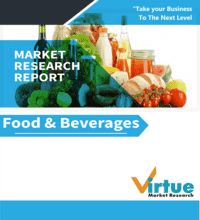Asia Pacific Clean Label Ingredients Market Size (2025-2030)
The Asia Pacific Clean Label Ingredients Market was valued at USD 10.40 billion in 2024 and is projected to reach a market size of USD 16.11 billion by the end of 2030. Over the forecast period of 2025-2030, the market is projected to grow at a CAGR of 7.57%.
The Asia-Pacific clean label ingredients market describes a sector that emphasizes natural and minimally processed food components that do not contain any artificial additives, preservatives, or synthetic chemicals. Such a market is propelled by consumer demand for openness to the user, healthier options, and products considered safe and reliable. Consumer awareness of health and nutrition has indeed forced producers to revamp their products with plant-based, organic, and non-GMO ingredients. This market covers a wide range of products, such as beverages, bakery, dairy, and ready-to-eat food, which demonstrates that the clean label concept has been universally accepted in the food and beverage industry segments. On their part, the major players are focusing on innovation, sustainability, and the transparency of the labeling to be in line with the new consumer and regulatory expectations. The trends in the different regions show that India, China, and the countries of Southeast Asia are adopting clean label solutions due to changing eating habits and urban lifestyles. Nevertheless, there are still issues such as the high cost of production, limitations in the supply chain, and the difficulty of maintaining the quality of the ingredients that are significant concerns for the stakeholders. To sum up, the Asia-Pacific clean label ingredients market is a fine example of the intricate interplay between the health-conscious consumer-driven demand and the industry's efforts to innovate responsibly, thereby making it a vital segment of the food and beverage industry.
Key Market Insights:
There is a notable shift towards health and wellness, with up to 60% of consumers across markets considering healthy aging a top priority. This trend is influencing the demand for clean-label ingredients, as consumers seek products that support long-term health and well-being. McKinsey & Company
Market Drivers:
Growing Consumer Preference for Transparency and Natural Ingredients is Driving Clean Label Adoption in the Asia Pacific.
Health-aware consumers in the Asia Pacific are progressively turning to foods that have easy-to-understand and recognizable ingredients and are free or almost free of artificial additives. The urban millennials and wellness-oriented groups emphasize to the utmost degree the necessity of transparency, and thus, they are very likely to check labels before making their purchase. The change in the demand for goods makes food and beverage producers reformulate their products with natural, non-GMO, and additive-free ingredients. Retailers are responding by promoting clean-label products, which leads to a strong demand in the market. This consumer-driven emphasis on health, sustainability, and trust is the major factor that is leading to the widespread use of clean label ingredients in the different sectors of packaged foods, dairy, and beverages.
Technological Innovations in Natural Ingredient Processing are Accelerating Market Growth.
Innovations in food processing and ingredient extraction are allowing producers to supply top-notch natural additives that do not lose flavor, texture, or shelf life. The use of enzymes for extraction, fermentation, and plant-based emulsification is one of the techniques that is broadening both the product range and the functionality of clean-label ingredients. These new technologies give brands the option to keep their products working as before while consumers demand more natural and transparent formulations. As a result, firms are in a position to extend the production of the clean label at a great pace and thus, a wide variety of applications such as snacks, beverages, dairy, and bakery products can be reached, which, in turn, leads to market growth.
Market Restraints and Challenges:
The Asia Pacific Clean Label Ingredients Market is a little different. It is being affected by a slowdown in growth that is due to various obstacles and challenges. The high production costs act as a barrier to widespread adoption. The reason is that the sourcing of natural, minimally processed ingredients needs to be done by using advanced technology and quality controls that are usually done under strict conditions, thereby increasing the product prices. On top of that, regulatory complexity across the region is a tough nut to crack for the market as well. The inconsistency of the standards of labeling and the requirements of compliance makes it hard for manufacturers to maintain uniformity. Besides that, the market faces problems with the stability of ingredients and their shelf life. The natural alternatives may change the product's texture, flavor, and longevity, thus requiring the expertise of advanced formulation. What is more, the limited consumer education and awareness of the benefits of clean-label products can slow the rate of product acceptance. Therefore, it needs continuous efforts to build trust and understanding among end-users.
Market Opportunities:
One of the driving forces behind the Asia Pacific Clean Label Ingredients Market expansion is the change in consumer preference due to the emergence of new food trends. Health consciousness has been on the rise in the entire region, and as a result, there is a strong demand for products with natural and easily recognizable ingredients that have hardly any artificial additives. This situation makes it possible for manufacturers to innovate and gain brand trust by giving transparent information on the labeling. On the other hand, the explosive growth of functional foods, nutraceuticals, and plant-based alternatives is a very profitable way to introduce clean-label ingredients by which companies can use naturally derived components like prebiotics, plant proteins, and natural colorants in their premium, health-focused offerings. Such markets as Japan, South Korea, Australia, India, and China are the ones that can benefit the most from these trends, where consumer awareness, disposable income, and demand for wellness-driven diets are the main factors that speed up the adoption of clean-label products.
ASIA PACIFIC CLEAN LABEL INGREDIENTS MARKET REPORT COVERAGE:
|
REPORT METRIC |
DETAILS |
|
Market Size Available |
2024 - 2030 |
|
Base Year |
2024 |
|
Forecast Period |
2025 - 2030 |
|
CAGR |
7.57% |
|
Segments Covered |
By Type, application, and Region |
|
Various Analyses Covered |
Regional & Country Level Analysis, Segment-Level Analysis, DROC, PESTLE Analysis, Porter’s Five Forces Analysis, Competitive Landscape, Analyst Overview on Investment Opportunities |
|
Regional Scope |
APAC, India, japan, australia, newzealand, south lorea, china |
|
Key Companies Profiled |
Cargill, Incorporated, Archer Daniels Midland Company (ADM) Koninklijke DSM N.V., Frutarom (International Flavors & Fragrances Inc.), Kerry Group plc Tate & Lyle PLC, Corbion N.V., DuPont de Nemours, Inc., Sensient Technologies Corporation, Ingredion , Incorporated |
Asia Pacific Clean Label Ingredients Market Segmentation:
Asia Pacific Clean Label Ingredients Market Segmentation By Type:
- Natural Colors
- Natural Flavors
- Flours
- Fruit & Vegetable Ingredients
- Starch & Sweeteners
- Preservatives
- Others
Natural Colors primarily lead the Asia Pacific Clean Label Ingredients Market as they are progressively being implemented in food and beverage products to substitute synthetic dyes. Consumers in the region are getting more conscious of their health and are doubtful of artificial additives, which compel food manufacturers to use plant-based colorants such as turmeric, beetroot, spirulina, and paprika. The demand for colored food products from bakery, confectionery, and dairy industries that are visually attractive and naturally formulated has also increased significantly; thus, this demand is getting amplified further. On top of that, strict regulatory frameworks and the increasing consumer advocacy for transparency in labeling are some of the factors that brands are using to promote natural coloring agents to attract customers. Hence, natural colors have turned out to be the most suitable option for manufacturers to not only increase product attractiveness but also to elevate brand trustworthiness, thereby confirming their status as the largest segment in the market.
Natural Flavors lead the fastest-growing segment mainly because of the regional preference changes to authentic taste experiences and clean ingredient labels. Consumers in markets like India, China, and Japan are more and more inclined to products with easily recognizable, naturally sourced flavor profiles. The prevalence of plant-based and functional food trends has been a significant factor in the rapid pace of the transition to the use of natural flavoring agents sourced from herbs, fruits, and botanicals. On top of that, improvements in extraction technologies, such as cold-pressing and enzymatic processes, have enhanced flavor stability and intensity; thus, this growth is being supported to a great extent. Besides that, the increasing demand for ready-to-drink beverages, natural snacks, and minimally processed foods is the reason behind the surge in the use of clean-label flavoring ingredients, which makes natural flavors the most rapidly expanding type in the regional market.
Asia Pacific Clean Label Ingredients Market Segmentation By Application:
- Beverages
- Bakery & Confectionery
- Sauce & Condiment
- Dairy & Frozen Desserts
- Processed Foods
- Others
Processed foods are the major consumers of clean-label ingredients in the Asia Pacific region, which is mainly due to the rapid urbanization and changing dietary habits in the region. Consumers are more and more inclined towards ready-to-eat meals, snacks, and convenience foods that combine taste with the use of health-conscious ingredients. Food manufacturers are extensively using clean label solutions such as natural preservatives, plant-based colorants, and non-GMO starches to phase out synthetic additives while at the same time keeping the product shelf life and sensory appeal intact. The rise of e-commerce grocery platforms and the growing middle-class populations in countries like China, India, and Indonesia have, together, increased the demand for clean-label processed foods. The dominance of this segment is thus supported by the strong presence of multinational food brands that are localizing formulations to meet regional preferences for authenticity, freshness, and transparency.
Beverages account for the most significant share of the growth of clean label ingredients in the Asia Pacific region over the past year. This rise is essentially caused by the hefty movement to natural and functional drinks, e.g., fruit-based beverages, plant-based alternatives, and probiotic-infused formulations. Customers, particularly millennials and Gen Z, are very diligent in looking for drinks that not only refresh but also add to their health and are free from artificial flavors or sweeteners. The innovation landscape is abundant—companies are launching clean label formulations comprising botanical extracts, organic acids, and natural colors. Japan, South Korea, and Australia, among others, are leading this change, with the local beverage manufacturers reshaping their existing portfolios to be in line with the "clean and green" movement. This quick growth is a clear indication of how changing lifestyle patterns and wellness-centric consumption are shaping the beverage industry's future in the region.
Asia Pacific Clean Label Ingredients Market Segmentation: Regional Analysis:
- China
- Japan
- South Korea
- India
- Australia & New Zealand
- Rest of Asia-Pacific
China is the major market for the Asia Pacific Clean Label Ingredients trend. The growth of the country's food and beverage industry, along with the increasing consumer demand for product labeling transparency, has been the main factor driving the market in the region. The urban population in the nation has become very health-conscious and is mostly looking for natural, organic, and additive-free products. Statista reports that more than 72% of Chinese consumers now opt for foods with fewer artificial ingredients, which is a noticeable cultural change towards cleaner consumption. The government's stricter food safety regulations and its focus on traceability standards have made the producers even more eager to use clean-label alternatives in their product reformulations. Besides that, both local and foreign ingredient producers are turning to natural colorants, sweeteners, and preservatives to meet the changing consumer preferences. The country's strong manufacturing base, coupled with the growing retail and e-commerce sectors, is still making it a leader in the regional market.
India distinguishes itself as the fastes/1t-growing market of the Asia Pacific Clean Label Ingredients sector. The growth of the country's processed food industry and the increasing middle-class population are the main factors behind this rise. The general shift from conventional to natural and minimally processed foods has been greatly influenced by the fast urbanization and the rising awareness of health and preventive medicine. According to Nielsen, nearly 68% of Indian consumers are very likely to check the ingredient list before purchasing a packaged product, which indicates a significant change in consumer behavior. The market is also thriving on the large-scale food chain's influence, the local organic brands, and the government-supported initiatives for food safety and clean manufacturing. The boom in plant-based and vegetarian product innovations is, therefore, the main reason that natural stabilizers, flavors, and sweeteners are in high demand. With continuous product innovation and retail expansion, India is set to be the most dynamic and rapidly advancing clean-label market in the region.
COVID-19 Impact Analysis:
The COVID-19 pandemic changed the Asia Pacific Clean Label Ingredients Market in a big way and had many effects on consumer preferences, manufacturing practices, and the supply chain across the whole region. At the beginning of the outbreak, the market was hindered heavily due to disturbances in the sourcing of raw materials, and in logistics and production as a result of lockdowns and trade restrictions. After the pandemic arrived, it also improved the public interest in health, safety, and immunity. So, consumers in big economies like China, India, Japan, and Australia started to demand cleaner and more natural products with easily recognizable ingredients in their food and drinks. Health consciousness becoming a trend was the driving force behind the companies to reformulate their products with minimal additives, natural preservatives, and plant-based components, thus showing a growing commitment to transparency and wellness. Moreover, the situation has sped up the transition to local sourcing to cut off import dependency and encouraged innovation in clean label standards using the new technologies such as natural fermentation, enzyme modification, and plant extraction. E-commerce platforms turned into the main distribution channels that allowed consumers to get clean-label products even during lockdown periods. At the same time, digital transparency tools like QR code labeling and blockchain traceability became more popular. Regulatory bodies enhanced the food safety systems that made it easier for manufacturers to use high-quality, sustainable, and traceable ingredients. After the initial difficulties, the pandemic became a trigger for the long-term market transformation - the pandemic drove the cooperation among suppliers, food processors, and startups, and helped to position clean label ingredients as one of the main sources of food innovation in the region. In the end, the crisis not only challenged the market but also accelerated a shift that would be permanent toward authenticity, sustainability, and consumer trust. It, therefore, firmly established clean label products as the new standard of health-conscious living across the Asia Pacific.
Latest Market News:
- In April 2024, Syensqo completed the acquisition of South Korea’s JinYoung Bio, a specialty cosmetic-ingredients supplier known for ceramide technologies; the deal immediately enabled Syensqo to launch a new biomimetic ceramide range (Cerafy™) and expand R&D and manufacturing reach into the Korean market.
- In March 2024, Symrise and India’s Virchow Group announced a joint venture (Vizag Care Ingredients Private Limited) to manufacture personal-care and specialty cosmetic ingredients in Visakhapatnam, India; production was planned to start in H1 2024 and the release notes Virchow Group employs over 5,000 people and posts roughly €750 million annual sales, while Symrise reported ~€4.7 billion sales for 2023, numbers underscoring the scale behind this APAC manufacturing push.
Latest Trends and Developments:
The Asia-Pacific clean label ingredient market is growing and gaining momentum due to the changing consumer preferences, support from regulations, and advancements in technology. Customers everywhere in the region are a lot more concerned about transparency and making healthy choices, and thus are looking for natural, organic, and minimally processed ingredients. Local governments are facilitating clear labeling and healthier formulations by means of such measures as Singapore’s Nutri-Grade and Australia’s Health Star Rating, thus manufacturers get the cleanest ingredients. Innovation in extraction and processing technologies, like enzyme treatments and high-pressure processing, is raising the functionality and the natural ingredient’s stability, thereby making them more feasible for commercial utilization. The rise in popularity of plant-based and allergen-free products is creating more demand, whereas the leading players, such as Cargill, ADM, DSM, DuPont, Kerry, Ingredion, Tate & Lyle, Sensient, Corbion, and Groupe Limagrain, are focusing on innovation, sustainability, and health-conscious offerings to meet the changing consumer requirements. In short, the market is set for a vibrant turn and further growth throughout the Asia-Pacific region.
Key Players in the Market:
- Cargill, Incorporated
- Archer Daniels Midland Company (ADM)
- Koninklijke DSM N.V.
- Frutarom (International Flavors & Fragrances Inc.)
- Kerry Group plc
- Tate & Lyle PLC
- Corbion N.V.
- DuPont de Nemours, Inc.
- Sensient Technologies Corporation
- Ingredion Incorporated
Chapter 1. Asia Pacific Clean Label Ingredients Market – SCOPE & METHODOLOGY
1.1. Market Segmentation
1.2. Scope, Assumptions & Limitations
1.3. Research Methodology
1.4. Primary Sources.
1.5. Secondary Sources
Chapter 2. ASIA PACIFIC CLEAN LABEL INGREDIENTS MARKET – EXECUTIVE SUMMARY
2.1. Market Size & Forecast – (2025 – 2030) ($M/$Bn)
2.2. Key Trends & Insights
2.2.1. Demand Side
2.2.2. Supply Side
2.3. Attractive Investment Propositions
2.4. COVID-19 Impact Analysis
Chapter 3. ASIA PACIFIC CLEAN LABEL INGREDIENTS MARKET – COMPETITION SCENARIO
3.1. Market Share Analysis & Company Benchmarking
3.2. Competitive Strategy & Development Scenario
3.3. Competitive Pricing Analysis
3.4. Supplier-Distributor Analysis
Chapter 4. ASIA PACIFIC CLEAN LABEL INGREDIENTS MARKET - ENTRY SCENARIO
4.1. Regulatory Scenario
4.2. Case Studies – Key Start-ups
4.3. Customer Analysis
4.4. PESTLE Analysis
4.5. Porters Five Force Model
4.5.1. Bargaining Asia Pacific Clean Label Ingredients of Suppliers
4.5.2. Bargaining Risk Analytics s of Customers
4.5.3. Threat of New Entrants
4.5.4. Rivalry among Existing Players
4.5.5. Threat of Substitutes Players
4.5.6. Threat of Substitutes
Chapter 5. ASIA PACIFIC CLEAN LABEL INGREDIENTS MARKET - LANDSCAPE
5.1. Value Chain Analysis – Key Stakeholders Impact Analysis
5.2. Market Drivers
5.3. Market Restraints/Challenges
5.4. Market Opportunities
Chapter 6. ASIA PACIFIC CLEAN LABEL INGREDIENTS MARKET – By Type
6.1 Introduction/Key Findings
6.2 Natural Colors
6.3 Natural Flavors
6.4 Flours
6.5 Fruit & Vegetable Ingredients
6.6 Starch & Sweeteners
6.7 Preservatives
6.8 Others
6.9 Y-O-Y Growth trend Analysis By Type
6.10 Absolute $ Opportunity Analysis By Type , 2025-2030
Chapter 7. ASIA PACIFIC CLEAN LABEL INGREDIENTS MARKET – By Application
7.1 Introduction/Key Findings
7.2 Beverages
7.3 Bakery & Confectionery
7.4 Sauce & Condiment
7.5 Dairy & Frozen Desserts
7.6 Processed Foods
7.7 Others
7.8 Y-O-Y Growth trend Analysis By Application
7.9 Absolute $ Opportunity Analysis By Application , 2025-2030
Chapter 8. ASIA PACIFIC CLEAN LABEL INGREDIENTS MARKET - By Geography – Market Size, Forecast, Trends & Insights
8.1. Asia Pacific
8.1.1. By Country
8.1.1.1. China
8.1.1.2. Japan
8.1.1.3. South Korea
8.1.1.4. India
8.1.1.5. Australia & New Zealand
8.1.1.6. Rest of Asia-Pacific
8.1.2. By Type
8.1.3. By Application
8.1.4. Countries & Segments - Market Attractiveness Analysis
Chapter 9. ASIA PACIFIC CLEAN LABEL INGREDIENTS MARKET – Company Profiles – (Overview, Type Portfolio, Financials, Strategies & Developments)
9.1 Cargill, Incorporated
9.2 Archer Daniels Midland Company (ADM)
9.3 Koninklijke DSM N.V.
9.4 Frutarom (International Flavors & Fragrances Inc.)
9.5 Kerry Group plc
9.6 Tate & Lyle PLC
9.7 Corbion N.V.
9.8 DuPont de Nemours, Inc.
9.9 Sensient Technologies Corporation
9.10 Ingredion Incorporated
Download Sample
Choose License Type
2500
4250
5250
6900
Frequently Asked Questions
The market was valued at USD 10.40 billion in 2024 and is expected to reach USD 16.11 billion by 2030, growing at a CAGR of 7.57% during 2025–2030.
Natural colors are the largest segment, driven by consumer preference for plant-based colorants like turmeric, beetroot, and spirulina. Natural flavors are the fastest-growing segment due to increasing demand for authentic taste experiences.
Processed foods are the major consumers, followed by beverages, bakery, dairy, and sauces, reflecting the region’s urbanization, convenience-oriented diets, and health-conscious consumption trends.
China is the largest market, propelled by a health-conscious urban population and strict food safety regulations, while India is the fastest-growing market due to rising middle-class demand for natural, minimally processed foods.
Challenges include high production costs, regulatory complexity, and ingredient stability. Opportunities lie in rising consumer health awareness, demand for functional foods, plant-based products, and innovations in natural ingredient processing.



